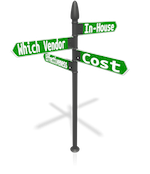 The demands of leadership change based on the environment and circumstances a leader faces. There can be no doubt that the current economic climate is unique. Businesses are facing more competition, a greater pace of change and more uncertainty than ever.
The demands of leadership change based on the environment and circumstances a leader faces. There can be no doubt that the current economic climate is unique. Businesses are facing more competition, a greater pace of change and more uncertainty than ever.
As a result the requirements for our leaders have changed as well. Certainly there are some skills and traits that leaders need regardless of the economic environment. The ability to attract, choose and retain top talent is a skill that transcends time and circumstances.
It is impossible to maintain a successful organization without great talent filling the halls. Talent certainly cures a lot of ills in other facets of a company. The one sustainable competitive advantage in this or any market is the quality of the people in the organization.
A leader who doesn’t attract, choose and retain top talent will not be a leader for long.
However, current economic conditions have dictated a change in emphasis to a new set of skills and traits for leaders. The new economy is characterized by an escalating pace of change, and the surge in competition from more diverse sources.
As a result, there are three “core skills” that an effective leader needs to exhibit.
The three skills are Flexibility, Ability To Learn and Strategic Thinking.
Flexibility
In today’s marketplace, a leader needs to be able to change direction based on an ever-changing analysis of the situation. The rapid pace of change in the market and arrival of new and unique competitors forces flexibility.
The dogged Type “A” leader who refuses to vary from the plan has a much harder time being successful in today’s market. This doesn’t mean the new leader changes for the sake of change. It does mean that planning is on going and fluid enough to meet rapidly changing conditions. Today’s leader must constantly compare and analyze new information and take the appropriate action.
Ability To Learn
The ability to learn is defined as quickly absorbing new information and putting it into use. Interestingly, we usually assign this requirement to entry-level employees. In today’s market, this skill is a must for the effective leader.
The changing market has caused many of the “traditional” solutions to problems to be rendered useless. A leader who relies on past solutions may be doomed to failure. Today’s leader needs to constantly upgrade their knowledge and skill set if they are to identify new and unique solutions to problems and challenges.
The best leaders I know all view learning as a continuous process that needs to keep pace with the pace of change around them. They are great students and constantly invest in their own education.
Strategic Thinking
Strategic thinking is the process of blending both short-term and long-term thinking and actions. The knee-jerk reaction when the environment is rapidly changing is to focus strictly on tactical issues. Putting out today’s fires. The strategic leader always weighs short-term actions against long-term consequences.
Selling out for either short or long-term is not the act of real leader in the new economy. Careful consideration is given to both and decisions made accordingly.
There are certainly other traits and characteristics of leaders but these three because more prominent in this market. The question now becomes how to select leaders in these challenging times.
The good news is the process of choosing leaders remains consistent. It is always best to rely on the Behavioral Model. This tells us that:
Past Behavior Predicts Future Behavior
Putting this into practice is as easy identifying the behaviors necessary for success in your environment and choosing people who behave that way.
When interviewing for flexibility, get specific examples from candidates of plans they adjusted on the fly. Question them about how the decision was made. Learn what options were considered and how the final decision was made.
Don’t just get one example.
Multiple examples lead to more consistent behavioral patterns. Using the behavioral model, it is possible to project the behavior to your environment with great accuracy.
For the ability to learn, get multiples examples of how the candidate has improved their skill set. Explore all the investments they made in their own education. Get specific examples of how they put the new information or skill into practice.
Never settle for generalities. Get specific examples with results attached.
For strategic thinking, get examples of decisions the candidate made that considered both short and long-term consequences. Go into great detail about everything that was considered.
Get examples of decisions made that sacrificed either the short or long-term. Once again, get all the details and have the candidate walk through everything that was considered in making the decisions.
For every example get as much detail as possible. Your goal is to learn all of the circumstances of the situation and all of the actions the candidate took. The more data collected, the better the hiring decision.
The traditional profile of a leader needs to be modified as a result of the current market conditions. New times call for new leadership models.
